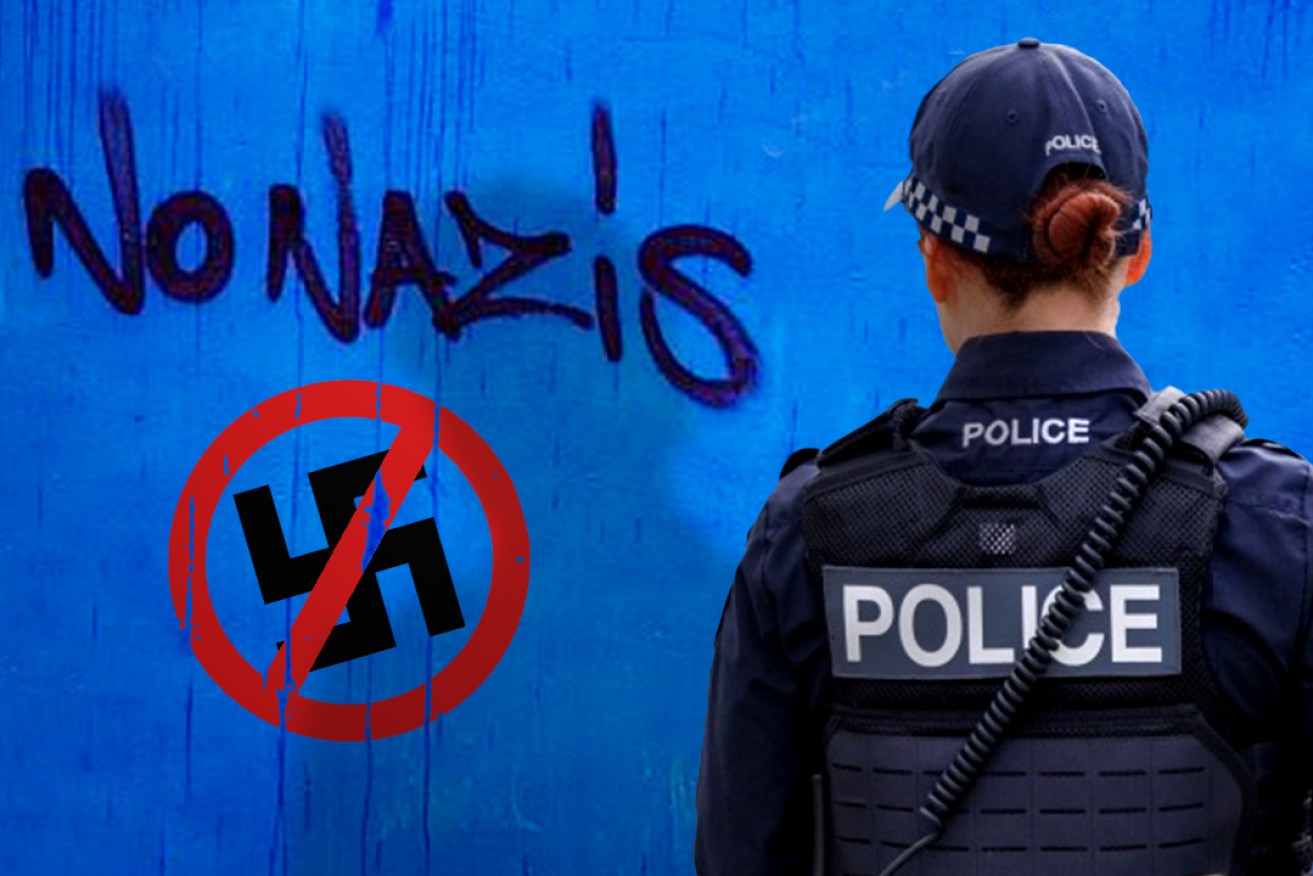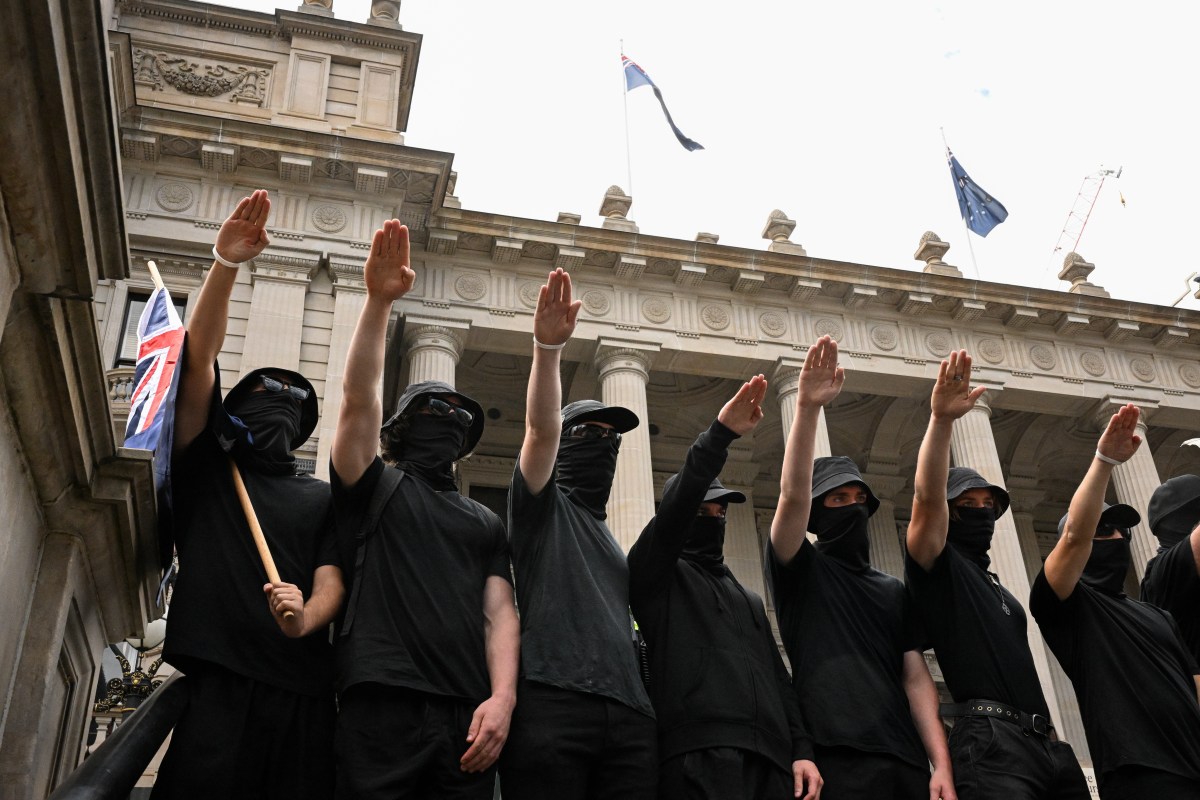SA Police want Nazi symbol ban expanded
SA Police say a parliamentary push to ban the public display of Nazi symbols in South Australia should be broadened.


Photos: AAP and Tony Lewis/InDaily. Image: Tom Aldahn
A committee examining legislation to prohibit the display of Nazi symbols in South Australia earlier this month heard evidence from senior South Australian police officers, who argued the Bill is “narrow in scope” and “[fails] to capture other symbols or behaviours of concern”.
The legislation, introduced by One Nation MLC Sarah Game, would set a maximum fine of $20,000 or 12 months’ imprisonment for displaying a Nazi symbol in a public place.
The Bill currently defines a Nazi symbol as a Hakenkreuz or “a symbol that so nearly resembles a Hakenkreuz that it is likely to be mistaken for a Hakenkreuz”.
Stuart McLean, SA Police assistant commissioner, security and emergency management service, argued that “simply identifying one symbol will create the opportunity for people who espouse that particular ideology to adopt other symbols”.
“Legislation that prohibits the use or display of symbols alone will provide those who espouse extremist ideology or hate the opportunity to publicly promote extremism through the use of alternative methods,” he told the committee on March 16.
“In addressing the public display of such material, it would be appropriate to also consider the production, possession and distribution of that material, including in the cyber environment.
“SAPOL continues to observe the public display of such material in the form of stickers, graffiti, posters, flyers, banners and in-person activism both in public places and visible from public places and online.”
McLean said SA Police “is not opposed to the intent” of the Nazi symbols ban but asked the committee to consider expanding its scope.
He also said police already “commonly” see neo-Nazi groups adopting other symbols.
“If you limit it to one symbol, it just creates the opportunity for other symbols to be embraced and it also allows for actions as well,” McLean said.
Our submission is that, in addressing this particular issue, it should be concerned with behaviour, actions, spoken word, written word, wherever it is displayed, including online; that its purpose is to incite violence, incite hatred.
“That is the issue to be addressed, and by limiting it to one particular symbol, it may be too narrow.”
The committee also heard from SA Police detective inspector George Fenwick, who said there has been an “increase of the public display of right-wing material, not necessarily all antisemitism”.
“That material has been displayed in the forms of stickers, graffiti, posters, letterbox drops, banner drops and in-person activism,” Fenwick said.
“We have also seen activism targeting Aboriginal people during Australia Day celebrations.
“We have seen activism targeting diverse groups, LGBTQIA+, and we have also seen graffiti targeting other people on the basis of race.”

Neo-Nazis outside Victorian parliament at a protest on Saturday, March 18, 2023. SA Police argue a ban on Nazi symbols should include “behaviour, actions, spoken word [and] written word”. Photo: James Ross/AAP
South Australia’s push to ban Nazi symbols follows similar bans in New South Wales and Victoria and more than 30 countries around the world, including Germany.
It has already prompted concerns from the SA History Trust, firearms groups, collectors and RSLs about the potential impact on Nazi-era historical collections and educational displays.
The peak body for scale model clubs and plastic modellers has also expressed reservations about the draft Bill.
South Australia’s legislation does currently include exemptions for displays of Nazi symbols that serve a “legitimate public purpose”, although historical displays are not included.
The four exemptions are:
- Displays for a “genuine academic, artistic, religious or scientific purpose”.
- Displays for a “genuine cultural or education purpose”.
- Displays for the purpose of “publishing a fair and accurate report of any event or matter of public interest”.
- Displays in opposition to fascism, Nazism or neo-Nazism.
Asked whether he believed hobbyists, model-makers and collectors displaying Nazi symbols were serving a “legitimate public purpose”, assistant commissioner McLean said: “I think it would be behaviour that would clearly fall within the category of ‘it’s for an artistic purpose’ versus something for hatred.”
“The issue would be, I guess, in the middle when there is some ambiguity as to why the person has it,” he said.
“That’s why we believe that the legislation should consider the intent of the person for actually displaying the symbol or producing the particular item or the action.
“And if it was broad enough to capture symbols, actions, spoken word that took into consideration the intent, that may give the scope and the space that’s required.”
SAPOL’s written submission to the inquiry, which contains a list of other symbols of concern, was not published by the committee following a request from McLean, who said it was a “sensitive document”.
McLean also said of the legislation was passed, police officers would be trained on the difference between Nazi symbols and swastikas used for religious purposes.
The Jewish Community Council of South Australia (JCCSA), the peak body for Jewish organisations in SA, has also called for the legislation to go further, including the production of Nazi symbols.
“This would, for example, prohibit a tattoo artist from tattooing a Hakenkreuz. Sale of Nazi memorabilia and items with hate symbols should also be prohibited,” the JCCSA submitted in January.
There are a number of hate symbols which should be prohibited beyond the Hakenkreuz, including ephemeral symbols, such as public use of the sieg heil salute.
“One of our member organisations, the Adelaide Holocaust Museum, will outline a number of symbols used by Neo-Nazi and far-right groups.
“The Council hopes that any prohibition of Nazi, Neo-Nazi and other hate symbols could be constructed to both specifically ban known symbols while allowing inclusion of new hate symbols as they become apparent, for example through prescription of symbols in regulations updated as required.”
The inquiry continues.




